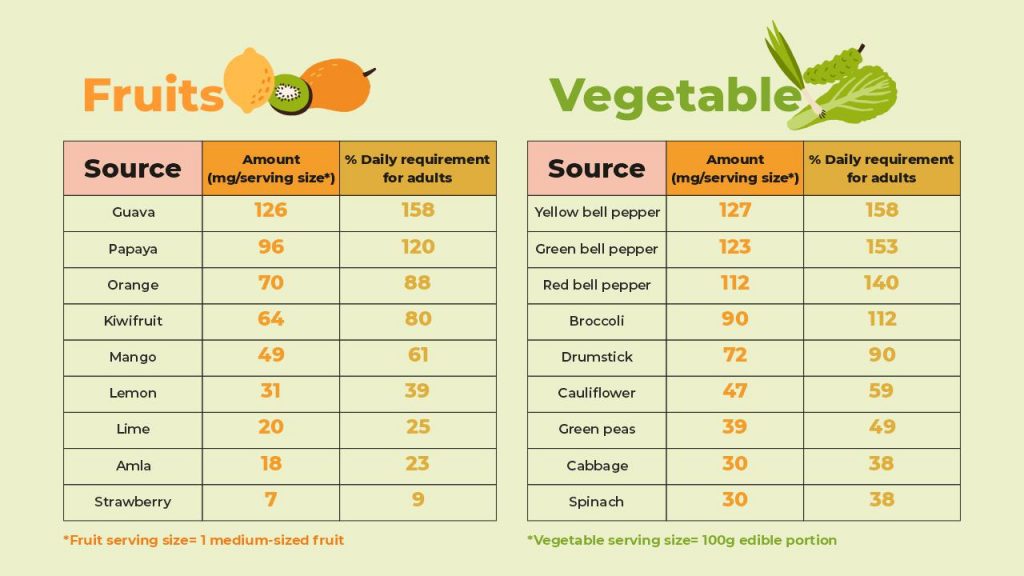
Vitamin C: Health Benefits, Deficiency, and Sources

Since the outbreak of Covid-19, there has been a lot of discussion about how we need to build our immunity. And consuming more vitamin C — through supplements or change in diet — has been topping the popularity charts. But, is vitamin C really the magic bullet it is made out to be? Let’s find out.
What is vitamin C and why do we need it?
Vitamin C or ascorbic acid is an essential, water-soluble vitamin that can neither be produced nor stored in the body. This is why one needs to take it daily to reap its benefits.
Among its various benefits, it primarily helps you by:
- Makes it harder for disease-causing microbes to infect your body and may even help in faster recovery from disease symptoms
- It is necessary for the formation of collagen (a type of protein), which plays an important role in healing wounds
- It is needed for the maintenance of skin, muscles, cartilage, bones, and teeth
- Improves the absorption of iron from foods
- Due to it’s powerful antioxidant activity, it may block some of the damage caused by harmful molecules called free radicals, which are produced in our bodies due to exposure to pollution, the sun’s UV-radiations, and stress
- Regular intake may improve physical endurance in athletes and may also prevent early aging
What happens if you don’t have enough?
Deficiency of vitamin C may impair the body’s immunity and repair functions, which may lead to increased risk of infections, delayed wound healing, swelling and bleeding of gums, and dry-scaly skin.
It’s also important to note that smokers and those exposed to second-hand smoke need an extra 35mg of this vitamin per day as they have higher levels of harmful free radicals in their bodies.
How much vitamin C do you need?
The amount of this vitamin you require each day depends on your age, gender, and physiological needs. The National Institute of Nutrition (NIN) recommends the following daily dietary allowance (RDA).

Sources
Fresh fruits and vegetables are the best sources. You may get recommended amounts by eating a variety of foods, including the following:

Consuming fortified foods and beverages may also help meet your needs. If you are buying packaged food and want to know if it has vitamin C, check the nutrition label.
Also read: Decoding Nutrition Labels: How You Can Choose to Eat Healthy
Also, keep in mind that ascorbic acid is quite unstable and may easily be damaged by exposure to heat, air (oxygen), and light. You can prevent it’s loss from your foods by following these simple rules:
1. Try to have raw fruits and vegetables. Cooking vitamin C-rich foods at high-heat or for prolonged durations may reduce the vitamin content. Quick heating methods like microwaving, steaming, and blanching may reduce these losses
2. Do not leave cut fruits and vegetables open or store them for long durations, to avoid oxidation
3. Exposure to light may also reduce the vitamin C content. So, a tetra pack of orange juice would be a better choice than a clear bottle
Also watch: How to increase your vegetable intake?
How to maintain vitamin C levels in the body
Following these simple guidelines can help maintain optimum levels:
1. Eat a diverse diet containing at least one raw portion of vitamin-C rich fruits and vegetables.
2. Cook vitamin C-rich foods on low heat and store them in air-tight containers only for short durations.
3. Avoid using tobacco, alcohol, and drugs, which may help reduce the risk of developing deficiency.
And if you think you are deficient, do not self-medicate. Consult your doctor or dietitian instead. They can assess your symptoms and dietary patterns to find out if your vitamin C intake is sufficient. If not, they may prescribe you a better diet along with supplements, if needed.
References
1. Carr AC, Maggini S. Vitamin C and Immune Function. Nutrients 2017; 9: 1211.
2. Chambial S, Dwivedi S, Shukla KK, et al. Vitamin C in Disease Prevention and Cure: An Overview. Indian J Clin Biochem 2013; 28: 314–28.
3. Doseděl M, Jirkovský E, Macáková K, et al. Vitamin C—Sources, Physiological Role, Kinetics, Deficiency, Use, Toxicity, and Determination. Nutrients 2021; 13: 615.
4. ICMR-National Institute of Nutrition. Recommended dietary allowances and estimated average nutrient requirements for Indians – A report of the expert group. Hyderabad, India: Indian Council for Medical Research, 2020.
5. Longvah T, Ananthan R, Bhaskarachary K, et al. Indian Food Composition Tables. Hyderabad, India: National Institute of Nutrition, Indian Council of Medical Research, 2017.
6. Ravindran RD, Vashist P, Gupta SK, et al. Prevalence and Risk Factors for Vitamin C Deficiency in North and South India: A Two Centre Population Based Study in People Aged 60 Years and Over. PLoS One 2011; 6: e28588.













